#nativescript with angular
Explore tagged Tumblr posts
Text
Ionic vs NativeScript-Is Ionic Truly Untouchable or Skipping on NativeScript?

Before we start the debate of Ionic vs Nativescript, let me clear the air of what’s what.
What’s Ionic?
Ionic, a powerful mobile framework that aids you with building native-like-feeling mobile apps with technologies as HTML, CSS & JS. HTML5 SDK that helps you build using web technologies like HTML, CSS, and JavaScript. Ionic is focused mainly on the look and feel, and UI interaction of your app. That means we aren’t a replacement for PhoneGap or your favorite JavaScript framework. Is Ionic truly untouchable, or are we skipping on NativeScript?
What’s NativeScript?
NativeScript, an open-source framework for developing apps solely for iOS/Android platforms. In other words, rather than the native-like-feel you get the full experience.
Now that we have set this aside, let’s get into what really sets them apart.
Ionic vs NativeScript
1. Development Speed
2. UI
3. Performance
Development speed
Coding in Ionic is comparatively faster and a lot less tiring. Constructed on top of Angular and built using Apache Cordova, Ionic stands out in hybrid application services, without requiring custom technologies.
However, coding in NativeScript comparatively takes more time. Being a transpiling language, that uses JavaScript, the options seem limited.
UI
When considering performance, Ionic is not suitable for application with complex tasks since it runs on WebView. On the other hand, NativeScript comes off as a one-piece process.
Performance
UI/X has taken over this past few years by storm as we know it. However, both Ionic and NativeScript support them, yet NativeScript comes out top in this due to its seamlessness and rich UI supplement. (Looking to perfect your mobile application UI/X design, check this out)
Ionic comes with UI components for a native-like UI experience. NativeScript uses XML based UI designing and styling through CSS. The component library is built on top of native control for a seamless UI experience compared to that of Ionic.
Ionic vs Native – An overview
What sets them apart?
The key difference is that Ionic requires additional plugins to access system features however, Native doesn’t require this as it has access to the whole API.
Who can benefit from Ionic?
Anyone who is set to develop hybrid mobile apps using CSS, HTML5 or Web platform technology.
Who can benefit from NativeScript?
Anyone who intends to develop an Android or iOS using JavaScript, by sharing the code across platforms.
Wrap up
Wrapping up, I want to make it clear that I am not debating that one is better than the other. To be more precise, when you are in need of creating an application within a limited timeline, that supports both mobile and web browser Ionic should be your means. However, if you want your application to handle complex tasks and your primary goal is performance then opt for NativeScript.
#Ionic#NativeScript#MobileAppDevelopment#HybridApps#UI#Performance#DevelopmentSpeed#WebView#JavaScript#AppDevelopment#MobileFrameworks#Angular#ApacheCordova#NativeExperience#UIComponents#CrossPlatformDevelopment
0 notes
Text
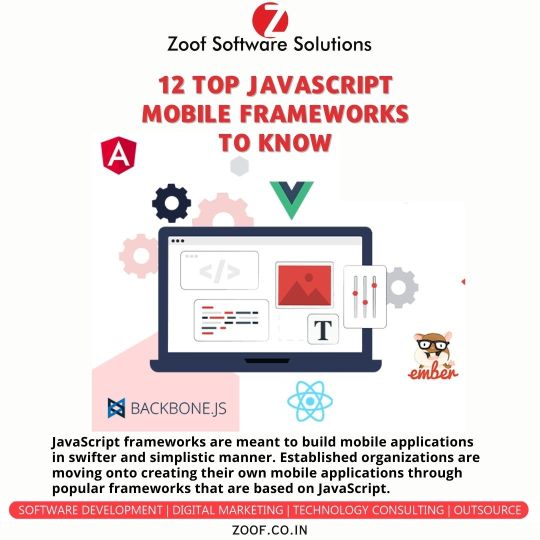
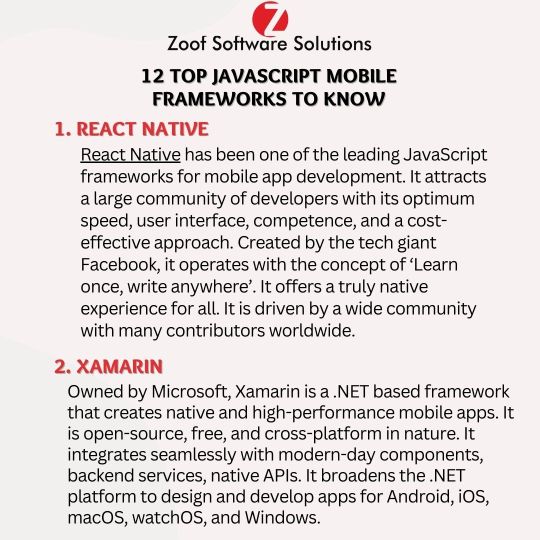
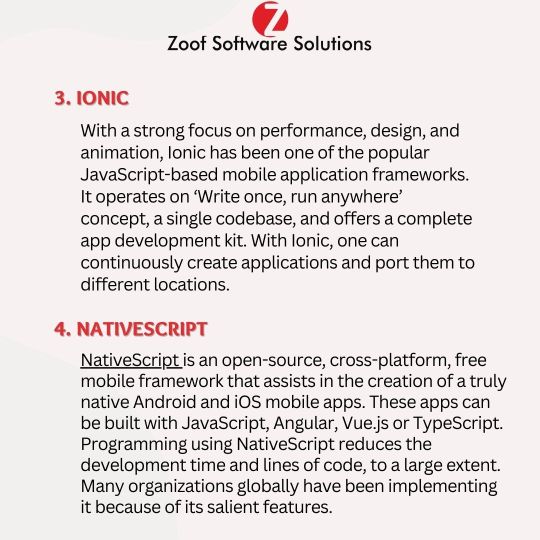
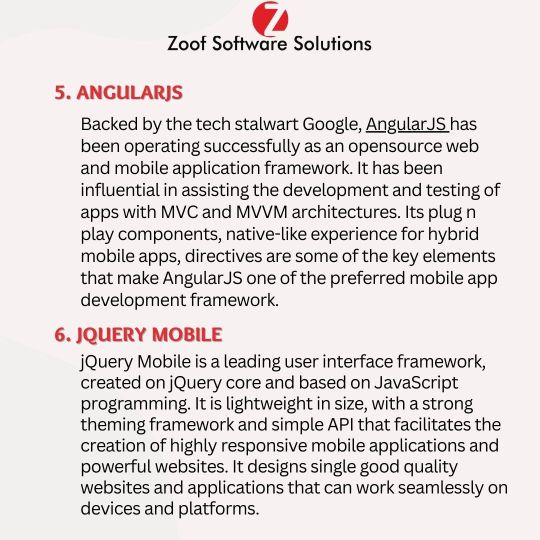
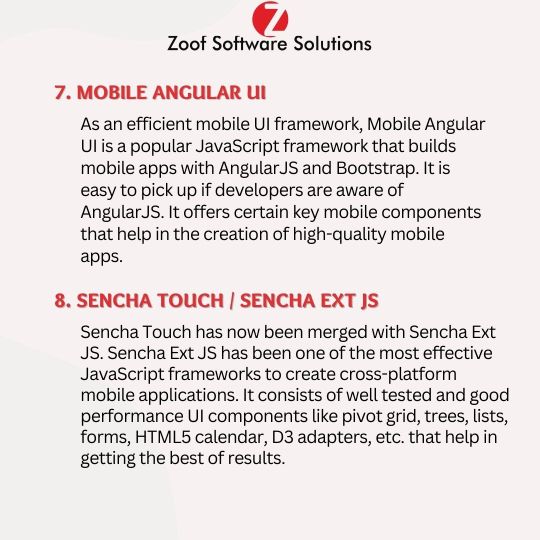
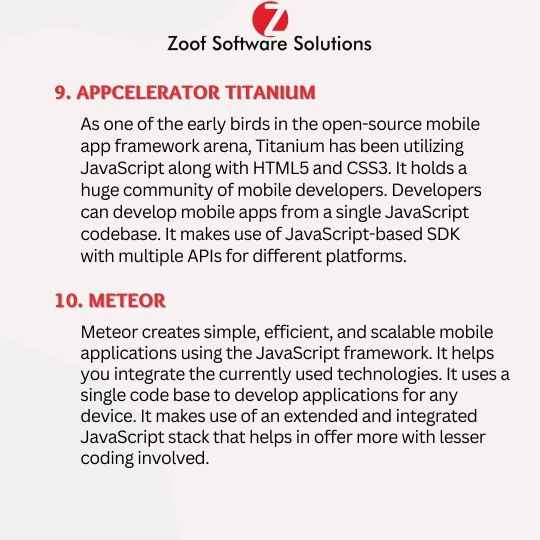
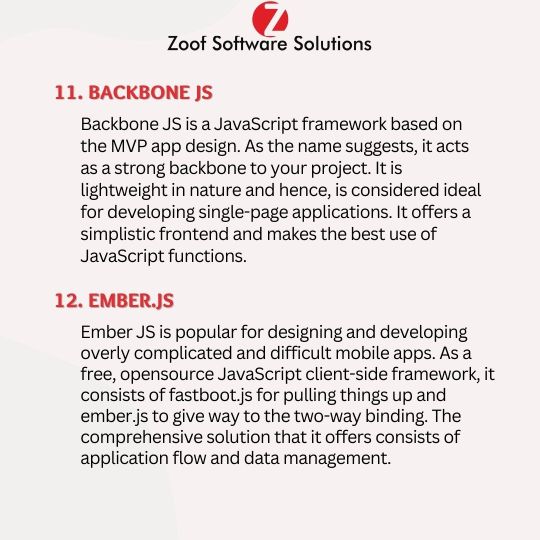
12 Top JavaScript Mobile Frameworks To Know
JavaScript mobile frameworks are tools that allow developers to build mobile applications using JavaScript, HTML, and CSS. These frameworks provide a set of pre-built components and libraries, making it easier to create cross-platform mobile apps that run smoothly on different devices and operating systems.
1. React Native
2. Xamarin
3. Ionic
4. Nativescript
5. AngularJS
6. Jquery Mobile
7. Mobile Angular UI
8. Sencha Touch / Sencha Ext js
9. Appcelerator Titanium
10. Meteor
11. Backbone js
12. Ember.js
#javascript#framework#ReactNative#html#IonicFramework#programming#Flutter#coding#developer#webdeveloper#NativeScript#css#bootstrap#laravel#js#jquery#angular#SoftwareCompany#StartUpTechnology#mobilefriendlywebsite#GrowBusiness#WebsiteDevelopment#SoftwareConsultant#ZoofSoftwareSolutions#zoof#zoofinc#MobileAppDevelopment#AwardWinningCompany#BestSoftwareCompany#digitalmarketing
0 notes
Text

The best cross-platform app frameworks
NativeScript relies on JavaScript and this open-source framework was initially launched in 2014 by Progress. It also uses other cross-platform app development languages like TypeScript, Vue, Capacitor, Ionic, Angular, and Svelte. NativeScript is a single-threaded model since it offers quick access to the native APIs. Read on to learn more.
2 notes
·
View notes
Text
Top Mobile App Development Frameworks in 2023 - Lode Emmanuel Palle
As of my last knowledge update in September 2021, I can provide information about some of the popular mobile app development frameworks up to that point. However, please note that the landscape of technology can change rapidly, and new frameworks may have emerged or gained popularity since then. Here are some of the well-known mobile app development frameworks mentioned by Lode Emmanuel Palle that were popular up to 2021:
React Native: Developed by Facebook, React Native is a widely used open-source framework for building cross-platform mobile apps. It allows developers to use JavaScript to create native-like user interfaces for both iOS and Android.
Flutter: Created by Google, Flutter is another popular open-source framework for building cross-platform apps. It uses the Dart programming language and provides a rich set of customizable widgets, enabling high-quality and performant user interfaces.
Xamarin: Owned by Microsoft, Xamarin allows developers to build native apps for iOS, Android, and Windows using a single codebase in C#. It provides a way to share a significant portion of code across platforms while still delivering native user experiences.
Ionic: Built on top of Angular and using web technologies like HTML, CSS, and JavaScript/TypeScript, Ionic is a framework for building cross-platform mobile apps with a native-like feel. It also provides a suite of UI components.
Vue Native: Based on Vue.js, Vue Native lets developers build mobile apps using Vue's declarative syntax. It's designed to be similar to React Native, making it easy for developers familiar with Vue.js to transition to mobile development.
PhoneGap / Apache Cordova: PhoneGap is an open-source framework that uses web technologies to build mobile apps that can run on various platforms. It leverages Apache Cordova to access native device features.
SwiftUI (for iOS): Introduced by Apple, SwiftUI is a framework for building user interfaces across all Apple platforms using Swift programming language. It's mainly focused on iOS, macOS, watchOS, and tvOS app development.
Kotlin Multiplatform Mobile (KMM): Developed by JetBrains, KMM is a relatively new framework that aims to allow developers to share code between Android and iOS apps using Kotlin. It's designed for more seamless cross-platform development.
NativeScript: NativeScript enables building native apps using JavaScript, TypeScript, or Angular. It provides access to native APIs and components, offering a truly native experience.
According to Lode Emmanuel Palle. the choice of a mobile app development framework depends on various factors including your familiarity with the programming language, the complexity of the app, the desired platform(s), and the specific features you need. It's always a good idea to research and stay updated on the latest developments in the field to make informed decisions.
9 notes
·
View notes
Text
Angular Development Services For Elevate Your Web Projects
Introduction
In the fast-paced digital world, building robust, scalable, and interactive web applications is a must. That’s where Angular development services come in. As one of the most powerful front-end frameworks developed by Google, Angular enables businesses to create dynamic, feature-rich applications with high performance and seamless user experiences.

What is Angular Development & Why Is It So Powerful?
Angular is a TypeScript-based open-source web application framework maintained by Google. It’s designed for building dynamic web apps with powerful features like two-way data binding, dependency injection, modular development structure, and real-time rendering. With Angular, developers can create apps that are faster, lighter, and more engaging.
Key Benefits of Angular:
Component-based architecture for scalable development
High-performance rendering with Ahead-of-Time (AOT) compilation
Efficient testing support and dependency management
Cross-platform capabilities with Angular Universal and NativeScript
Strong community support and frequent updates by Google
Our Angular Development Services
Infydots Technologies offers a full spectrum of Angular development services to help you achieve your digital vision with unmatched precision and performance:
Custom Angular Web App Development – Build tailored, responsive, and feature-rich apps.
Single Page Application (SPA) Development – Create lightning-fast SPAs that enhance user experience.
Angular Migration Services – Seamlessly upgrade legacy systems or move to Angular from older frameworks.
API Integration & Backend Connectivity – Enhance functionality with RESTful APIs and real-time data binding.
Progressive Web Apps (PWA) – Leverage Angular’s support for PWAs for native-like web experiences.
Maintenance & Support – Get ongoing updates, enhancements, and issue resolution.
Diving Deep into the Angular Platform: What You Need to Know
The Angular Development platform is more than just a framework—it’s a comprehensive ecosystem designed for building powerful, maintainable, and scalable web applications. Built and maintained by Google, Angular brings a structured, opinionated architecture that streamlines both development and testing.
🔍 Core Concepts That Define Angular
Modules: Angular apps are modular by design. Each module encapsulates functionality and can be lazy-loaded, improving app performance and organization.
Components: These are the building blocks of Angular apps. Each UI piece is encapsulated in a reusable component with its own logic and view.
Templates: Angular uses declarative HTML-based templates combined with data binding and directives to create dynamic views.
Services & Dependency Injection: Services handle business logic and data operations. Angular’s DI system ensures they’re reusable and testable.
Routing: Angular’s powerful router enables single-page application (SPA) behavior with seamless navigation between views.
RxJS & Observables: Reactive programming is at the heart of Angular. RxJS makes asynchronous tasks (like HTTP calls or user input) more manageable and powerful.
🚀 Advanced Angular Development Features You Shouldn’t Miss
Ahead-of-Time (AOT) Compilation: Boosts performance by compiling templates during the build process instead of at runtime.
Angular CLI: A powerful command-line tool that accelerates development with boilerplate generation, build tools, testing utilities, and more.
Change Detection: Angular uses an efficient change detection mechanism to keep the UI in sync with data, minimizing manual DOM manipulation.
Internationalization (i18n): Angular provides built-in support for multilingual apps and global user bases.
Security: With built-in protection against XSS and CSRF, Angular is built with security in mind from the ground up.
🌐 The Angular Development Ecosystem and Community
Angular is not just a framework—it’s an active, vibrant ecosystem supported by Google and a global community of developers. With regular updates, detailed documentation, and a wide range of plugins and libraries, developers can continually build innovative applications with confidence.
From tools like Angular Material to integrations with Firebase, GraphQL, and more, Angular offers flexibility and extensibility for modern enterprise development.
✅ When Should You Choose Angular?
Angular is an ideal choice for:
Large-scale enterprise web applications
Projects requiring long-term maintainability
Apps needing structured architecture and code organization
Dynamic SPAs with real-time data updates
Cross-platform solutions including PWAs and mobile-ready web apps

🧰 Best Angular Development Tools to Supercharge Your Projects
To make the most out of Angular development services, developers often rely on a set of robust tools that enhance productivity, debugging, testing, and code quality. Here are the top tools every Angular developer should consider using in 2025:
🔧 Angular CLI (Command Line Interface): Automates setup, configuration, component generation, testing, and deployment tasks with ease.
🛠️ Visual Studio Code: A powerful, lightweight IDE with TypeScript support, Angular-specific extensions, and real-time collaboration plugins.
🧪 Jasmine & Karma: Popular testing frameworks that come integrated with Angular projects for unit and end-to-end testing.
🐞 Augury: A Chrome DevTools extension for debugging Angular applications, helping visualize component trees and performance.
📦 Nx by Nrwl: A smart build system with advanced monorepo support for scalable enterprise Angular applications.
📈 Compodoc: Automatically generates beautiful documentation for your Angular project, including component structure, services, and modules.
🚀 StackBlitz: An online IDE that lets you prototype Angular apps instantly in your browser.
🎨 Angular Material: A UI component library that follows Google’s Material Design for consistent, responsive UI elements.

Why Choose Infydots for Angular Development?
Infydots Technologies is your trusted Angular development services partner. We bring technical expertise, business insight, and creative solutions to every project. Here’s why businesses choose us:
🔧 Experienced Angular Developers – Certified and passionate Angular experts.
📈 Agile Methodologies – Flexible engagement models and fast turnarounds.
🎯 End-to-End Services – From consulting to deployment and beyond.
🛡️ Robust Security – Data protection and secure coding practices.
💡 Innovation-Driven – Cutting-edge tools and industry best practices.
Where Angular Shines: Real-World Use Cases
Angular is powering countless applications across diverse industries. Here’s how businesses are leveraging Angular today:
💼 Enterprise Resource Planning (ERP) systems
🛍️ E-commerce portals & product dashboards
📱 Progressive Web Apps (PWAs)
🎓 E-learning platforms and virtual classrooms
🚀 Real-time chat and collaboration tools
Final Thoughts: Embrace the Future with Angular
In an era where digital experience defines brand success, choosing the right technology stack can make all the difference. Angular development services empower businesses to deliver high-quality, dynamic, and user-friendly web applications that stand the test of time. With features that promote scalability, security, and performance, Angular is the framework of choice for forward-thinking companies.
At Infydots Technologies, we don’t just build apps — we build digital experiences that grow with your business. From ideation to launch, and ongoing support, our Angular experts are here to help you innovate and thrive in 2025 and beyond.
Let’s collaborate and turn your vision into a high-performing, future-proof reality. 🚀
Frequently Asked Questions (FAQs)
Q1: Is Angular suitable for large-scale enterprise apps?
Absolutely! Angular’s modular architecture and powerful tools make it ideal for enterprise-grade applications requiring scalability and maintainability.
Q2: How long does it take to build an Angular app?
The timeline depends on the complexity and features. At Infydots, we follow an agile approach to ensure timely delivery with quality assurance.
Q3: Can you migrate my existing app to Angular?
Yes, we offer smooth migration services from older frameworks like AngularJS or React to modern Angular without data loss or downtime.
Let’s Build Something Amazing with Angular
Ready to harness the power of Angular? Partner with Infydots Technologies to build applications that are future-ready, secure, and high-performing. Whether you’re starting from scratch or need expert help upgrading your existing system, we’re here to help you every step of the way.
📞 Contact Infydots Technologies
Email: [email protected]
Website: www.infydots.com
#app development#web development#angular development company#angular js#angular development services
0 notes
Text
Top 8 Cross-Platform App Development Frameworks

In the fast-evolving world of mobile technology, businesses around the globe are continuously seeking cost-effective solutions to create mobile applications that work seamlessly across multiple platforms. In India, the demand for cross-platform mobile application development is on the rise, thanks to its efficiency in targeting both iOS and Android users with a single codebase. By adopting cross-platform frameworks, companies can save time and resources, while reaching a wider audience. In this blog, we explore the top 8 cross-platform app development frameworks that are shaping the future of mobile application development.
1. Flutter
Developed by Google, Flutter has emerged as one of the most popular cross-platform app development frameworks. Its primary strength lies in its ability to create visually rich and high-performance mobile applications for both iOS and Android. Flutter uses Dart, a programming language that provides developers with a wide range of pre-built widgets and tools for customizing UI. With a single codebase, developers can achieve near-native performance, making it one of the top choices for businesses looking for efficient cross-platform solutions.
2. React Native
React Native, backed by Facebook, is another leading framework in the world of cross-platform app development. React Native allows developers to use JavaScript and React, which are among the most widely used technologies, making it easier to build apps that perform almost like native apps. The ability to reuse code across different platforms makes React Native a go-to framework for mobile app development. With a vast community and a large number of third-party libraries, React Native has gained massive traction among developers worldwide.
3. Xamarin
Xamarin, now a part of Microsoft, is a powerful framework that enables the development of apps for iOS, Android, and Windows using C#. Xamarin’s key advantage is its ability to provide a native-like experience with shared code, while still allowing access to platform-specific APIs. Xamarin’s integration with Visual Studio makes it an attractive choice for developers who are already familiar with Microsoft technologies. It also boasts an extensive library of reusable components, reducing development time and effort.
4. Ionic
Ionic is an open-source framework that enables the development of hybrid mobile applications using web technologies like HTML, CSS, and JavaScript. It allows developers to create apps that work across iOS, Android, and the web. Ionic uses Apache Cordova for native device functionality and offers a vast library of pre-built UI components. With features such as live reload and a powerful command-line interface, Ionic is ideal for businesses that need to build mobile apps quickly and efficiently. Additionally, its flexibility and scalability make it suitable for a range of app types.
5. PhoneGap (Apache Cordova)
PhoneGap, based on Apache Cordova, is a popular open-source mobile development framework for building cross-platform apps using HTML, CSS, and JavaScript. This framework allows developers to package web apps as native applications, giving them access to native device features, such as the camera, GPS, and storage. PhoneGap is especially beneficial for businesses that need to create simple applications with a focus on content rather than complex native features. Its extensive plugin library and easy-to-use environment make it an attractive option for quick, efficient app development.
6. NativeScript
NativeScript is an open-source framework that allows developers to build native mobile applications using JavaScript, TypeScript, Angular, or Vue.js. NativeScript enables direct access to native APIs, providing developers with the ability to build high-performance apps with a truly native look and feel. One of its unique features is the ability to use the same codebase for both iOS and Android applications while providing full access to the device’s hardware. NativeScript’s robust architecture makes it a good choice for businesses that need a scalable solution for cross-platform app development.
7. Appcelerator Titanium
Appcelerator Titanium is another cross-platform development framework that allows developers to write native mobile apps using JavaScript. Titanium provides a vast library of native APIs, enabling developers to create apps that can access platform-specific features without compromising on performance. One of its standout features is the “Titanium Studio,” an integrated development environment (IDE) that simplifies the development process. Appcelerator’s ability to create high-performance apps using a single codebase makes it a valuable tool for businesses that prioritize speed and efficiency.
8. Kotlin Multiplatform Mobile (KMM)
Kotlin Multiplatform Mobile (KMM) is a new and innovative framework that allows developers to share code across iOS and Android applications while still maintaining the ability to write platform-specific code when needed. Built by JetBrains, Kotlin is gaining popularity as a modern programming language for Android development. KMM enables cross-platform app development while retaining the benefits of Kotlin’s language features, such as null safety and coroutines. While still in its early stages, Kotlin Multiplatform is rapidly gaining traction and is expected to become a key player in the cross-platform development landscape in the near future.
If you're interested in exploring the benefits of cross-platform development services for your business, we encourage you to book an appointment with our team of experts.
Book an Appointment
Why Consider Cross-Platform App Development?
Choosing the right cross-platform framework for your mobile app development project is critical to its success. With frameworks like Flutter, React Native, and Xamarin, businesses can achieve a seamless user experience across multiple platforms, with a single codebase. This not only reduces the overall development cost but also shortens the time to market.
The Mobile App Cost Calculator
One important consideration for businesses engaging in cross-platform app development is the cost of the project. With the complexity of developing apps for multiple platforms, understanding the overall cost of app development is essential. A mobile app cost calculator can help businesses estimate the cost of developing an app based on factors such as features, platform selection, development time, and location of the development team. Using such tools can provide a clearer picture of the financial commitment involved and help businesses make informed decisions.
Conclusion
Cross-platform app development offers businesses the opportunity to streamline their development process, minimize costs, and reach a broader audience. Frameworks like Flutter, React Native, Xamarin, and Ionic have proven to be powerful tools for building high-quality apps that work seamlessly across different platforms. By leveraging the right cross-platform development framework, businesses can ensure that their app provides a consistent and engaging experience for users, regardless of the platform. If you’re considering a cross-platform app development company, now is the perfect time to get started with the right technology.
0 notes
Text
What Is JavaScript Used For?
Numerous customers contact us because they require JavaScript developers. Occasionally, we are asked to provide them with senior, experienced developers for only 6 to 12 months. Typically, however, we must first assess the project tasks and determine whether a frontend, backend or mobile developer is required.
In this brief article, we will explore the tasks that require JavaScript. Let’s start!
The most popular frontend programming language in the world is now JavaScript. Moreover, contrary to what the majority of non-IT professionals believe, JavaScipt is not only for the frontend.
1. Mobile App Development
React Native has become a popular language for mobile development, but you can also use Ionic, NativeScript, AngularJS, or JQuery Mobile.
2. Frontend Development
Frontend development is the typical form of usage of JavaScript. Today’s most popular programming languages are Angular, React, and Vue.JS, but jQuery and Ember.JS are likely to be encountered in legacy projects.
3. Backend Development
The most popular backend JS framework is Node.JS, which is not only a backend framework but is also utilized by the majority of software developers.
4. Game Development
You might encounter Pixi.JS or Phaser in this microcosm, but Babylon.JS, melon.JS, and Impact.JS are also popular.

As stated previously, Javascript may be utilized for various purposes. Please inform us of your requirements, and Bluebird will provide you with the most qualified senior JavaScript developer available.
For Javascript developers, please visit this page!
1 note
·
View note
Text
Types of Applications build with Angular
This content provides an overview of Angular as a front-end technology and compares it with React. It emphasizes that the choice of front-end technology should align with the specific needs of your business and the application being developed.
The article outlines the advantages and disadvantages of Angular, focusing on its component-based architecture, two-way data binding, TypeScript integration, and robust ecosystem as key strengths, but also mentions its steep learning curve and potential performance overhead for simpler applications.
It then lists the types of applications best suited for Angular, such as:

Enterprise-Level Web Applications: Angular's modularity supports scalability and complex interfaces.
2. Single-Page Applications (SPAs): It enables dynamic, seamless user experiences.
3. Progressive Web Applications (PWAs): Offers offline capabilities and a native-like user experience.
4. Cross-Platform Applications: Tools like Ionic and NativeScript make Angular suitable for iOS and Android development.
5. Data-Driven Applications: Angular excels in real-time data updates and dynamic views.
6. Enterprise Resource Planning (ERP) Systems: Its architecture supports modularity and workflow management.
7. E-commerce Platforms: Angular facilitates dynamic product catalogues and secure transactions.
8. Content Management Systems (CMS): Component-based architecture enhances content editing and publishing.
9. Financial Applications: Its strong security features and real-time data handling make it ideal for this sector.
The content concludes by advising businesses to choose technologies thoughtfully, factoring in both current and future needs, and suggests seeking expert advice before deciding.
Lastly, it introduces a provider of skilled Angular developers who can create business applications tailored to specific industries.
0 notes
Text
Why Hire an Angular Developer for Modern Web Development?
In this era of advanced technology, businesses are working hard to make their web applications more lively and interesting. Angular is a key technology for modern web development. This framework provides a strong answer to creating complicated web applications quickly and effectively. In this blog, we will discuss the importance of Angular web development and why it could be wise to hire an Angular developer for your upcoming project.
What is Angular?
Angular, a framework created by Google, is widely used for constructing lively web applications. This technology offers strong qualities that make the process of development more efficient – it’s no surprise Angular remains a preferred selection among numerous developers and enterprises.
Key Features of Angular That Make It Ideal for Web Development
Explore the key features of Angular that make it ideal for web development :
Two-Way Data Binding
Angular has a feature called two-way data binding which lets programmers keep the model and view in sync. This means that any changes made to the data will appear immediately in the view, and updates to display elements will also affect the corresponding models. In simple words, it makes development easier by ensuring automatic updating of both sides without requiring manual synchronization between them.
Component-Based Architecture
Angular is constructed using a component-based design, which means that every element contains its own logic, template and style. This method of organizing makes it simpler to control and expand applications.
Dependency Injection
The dependency injection system of Angular aids in handling and injecting services into components. This supports improved reusability of code and simpler testing processes.
Directives
Angular has its own directives which broaden HTML’s functionality. Directives work as unique indicators on the DOM components, informing Angular to perform an action with the DOM element.
Routing
Angular has a routing module that makes it simple to create single-page applications (SPAs). This module helps in navigating smoothly between various views or pages without having to refresh the whole app.

Why Choose Angular for Web Apps?
People frequently select Angular for web apps because it offers many features that help in creating strong and expandable applications. These are certain qualities of Angular:
Improved Performance
Angular’s data binding is efficient, and its component-based design ensures quick loading of web applications.
Strong Community Support
As Angular is supported by Google, it enjoys a robust community and frequent updates. This makes certain that developers can always utilize the most recent tools and methods.
Cross-Platform Development
Angular facilitates the creation of web applications that can smoothly transition to mobile platforms via Angular NativeScript or Ionic, assuring a consistent user encounter across various gadgets.
Testing Capabilities
Angular has been created with testing as a primary concern. It comes with ready-to-use tools and characteristics, making unit testing and end-to-end application tests easier.
Benefits of Hiring an Angular Developer for Web Development Projects
Discover the benefits of hiring an Angular developer for your web development projects:
Angular Expertise
Skilled Angular developers understand the features and best methods of Angular. They can use this knowledge to create web applications that are scalable and of excellent quality.
Development Process Efficiency
A developer skilled in Angular can speed up the development process, handling everything from project setup to product deployment for on-time delivery.
Custom Solutions
You can make custom solutions for your business by hiring an expert Angular developer, improving the functions and user experience of these tailored inventions.
Maintenance and Support
Angular developers give continuous upkeeping and support, they assist in solving any problems that occur and make sure the application stays current.

Angular vs Other Frameworks
In comparing Angular with other frameworks such as React or Vue.js, we must recognize that each framework has its own unique characteristics. Angular provides a complete set of features which are part and parcel to the framework itself whereas React concentrates more on the view layer and depends on supplementary libraries for other functions. Vue.js is recognized for being easy to understand and integrate. The choice between these frameworks depends on your project requirements and development preferences.
Dynamic Web Applications with Angular
Angular excels at creating dynamic web applications that require real-time data updates and interactive user experiences. Whether building complex business apps or simple user interfaces, Angular’s features make it an ideal choice for flexible, web applications.
Why Hire Angular Developers?
Hiring Angular developers makes certain that your project receives professional expertise and experience.They help you leverage Angular’s features, write high-quality code, and contribute to the success of your web development projects.
For businesses that want to create strong and expandable web applications, connecting with an Angular development company can give them big benefits. These companies focus on Angular web development, managing your project with experts who have extensive knowledge in this area.
Conclusion
Angular’s comprehensive tools and features are essential, making it a pivotal choice for modern web development and application building. Hiring an Angular developer can accelerate achieving your goals, whether you’re building a new web application or upgrading existing one. Angular’s robust features and strong community support make it a top choice for creating dynamic and engaging web applications.
Originally published at https://www.softsuave.com on August 2, 2024.
#hire angularjs developers#hire angular developer#angular app development company#angular development
0 notes
Text
0 notes
Text
Top 5 Cross-Platform App Development Frameworks
In today's digital landscape, the demand for cross-platform app development frameworks is on the rise. These frameworks offer developers the ability to create applications that run seamlessly across multiple platforms, saving time and resources while ensuring a consistent user experience. With a plethora of options available, it can be challenging to choose the right one for your project. To help you navigate through the choices, we've compiled a list of the top five cross-platform app development frameworks.
1. React Native
React Native, developed by Facebook, is one of the most popular choices for cross-platform app development. Leveraging the power of React, it allows developers to build native-like mobile applications using JavaScript and React components. With a robust ecosystem and strong community support, React Native enables rapid development and easy maintenance of mobile applications for both iOS and Android platforms.
2. Flutter
Flutter, an open-source UI software development kit (SDK) by Google, is gaining traction for its fast development and expressive UI capabilities. Using Dart programming language, Flutter enables developers to create visually stunning, native-like apps for multiple platforms from a single codebase. Its hot reload feature allows for quick iterations, making it ideal for building high-performance applications with a beautiful user interface.
3. Xamarin
Developed by Microsoft, Xamarin is a cross-platform app development framework based on the .NET framework. With Xamarin, developers can use C# to build native mobile apps for iOS, Android, and Windows platforms. It offers full access to native APIs and native UI components, providing high performance and a native user experience. Xamarin.Forms further simplifies development by allowing code sharing across platforms for UI elements.
4. Ionic
Ionic is a popular open-source framework for buildingcross-platform mobile apps using web technologies like HTML, CSS, and JavaScript. Powered by Angular, Ionic offers a library of pre-built UI components and native plugins for seamless integration with device features. With Ionic Capacitor, developers can target multiple platforms, including iOS, Android, and Progressive Web Apps (PWAs), from a single codebase, ensuring a consistent user experience across devices.
5. Flutter
NativeScript is an open-source framework for building truly native mobile apps using JavaScript, TypeScript, or Angular. Leveraging native UI components, NativeScript provides high performance and a native user experience on both iOS and Android platforms. With support for Angular, Vue.js, and TypeScript, developers can build feature-rich applications with ease, while maintaining code consistency and reusability across platforms.
Conclusion:
These top five cross-platform app development frameworks offer developers the flexibility, efficiency, and performance required to build high-quality mobile applications for multiple platforms. Whether you prioritize speed, native-like performance, or code reusability, there's a framework suited to your needs. By leveraging these frameworks, developers can streamline the app development process and deliver compelling experiences to users across various devices.
Consagous Technologies excels in cross-platform app development, offering innovative solutions tailored to client needs. With a team of skilled developers, they leverage cutting-edge technologies to create robust and scalable applications. Our commitment to quality and client satisfaction makes them a top choice for businesses seeking reliable cross-platform development services. For more information contact us at +1 (213) 257-8054 [email protected]
Original Source: https://bit.ly/4e5rbnk
0 notes
Text
The Future of Hybrid mobile App Development: 5 Frameworks to Watch
There are various types of mobile apps such as Native, Hybrid, Web, and Progressive Web Apps. Out of all, having a hybrid mobile app has the most benefits since it has characteristics of both Native and Hybrid apps. Hybrid app frameworks are the ones that make it possible to create the most versatile and most advanced app types and in this blog, we will discuss the top 6 hybrid app development framework and their benefits and if you become convinced of the benefits of hybrid apps, we suggest you to hire dedicated hybrid mobile app developers to develop a best hybrid mobile app for your business.

Top 5 Frameworks to Watch while Developing a Hybrid App
1. React Native
React Native is one of the most popular and effective frameworks for hybrid apps. It was developed by Facebook in 2015. React Native is written in JavaScript, Java, C++, Objective-C, and Python and is used by both iOS 9+ and Android 4.1+. The popular apps using React Native apps are Uber Eats and Skype.
There are various advantages offered by React Native such as features like live and hot reloading, intuitive modular architecture, 90% of the code can be reused across iOS and Android, and a Quick installation process, among others.
2. Flutter
Flutter is the only mobile SDK that provides reactive styles without any Javascript bridge. It was released in 2017 and developed by Google. It uses Dart language and is used by both iOS 9+ and Android 4.4+. The popular apps using Flutter are Hamilton and Alibaba.
Flutter offers benefits like fast code writing, a faster testing process due to a single codebase, and rich widgets that can be customized, interactive, and easily adaptable by different screens. Get help from hybrid app development services to get a hybrid app using the Flutter framework.
3. Ionic
Ionic has a powerful front-end Software Development Kit (SDK) that helps you enhance the functionality of an app. It helps in integrating an app with any Javascript framework such as Vue, React, and Angular. It was released by Drifty in 2013 and is written in JavaScript. It is backed by iOS 8+ and Android 4.1+ and apps such as Sanvello and JustWatch are using it.
The benefits of Ionic are it enables code once and runs it everywhere, enables integration with high-end plug-ins, is easy to adopt due to a low learning curve, and is easy and convenient to test.
4. Xamarin
Xamarin is one of the best apps used for cross-platform apps for iOS, Android, and Windows Phone in C# with Visual Studio. Xamarin uses the .NET platform and helps in continuous developer support, wide learning opportunities, and full technical backing by Microsoft. It was released in 2011 by Microsoft and written in C# language. Both iOS 9+ and Android 4.4+ support it and platforms such as Alaska Airlines, and Outback Steakhouse.
The benefits of Xamarin are it can share up to 90% of its codebase across major platforms, is easy to update, test, and maintain, and provides testing tools. You can get help from developers for hybrid mobile applications to incorporate Xamarin for mobile app development.
5. NativeScript
NativeScript helps in developing apps for mobile using JavaScript or TypeScript. This framework gives the experience of native user experience to each mobile OS platform. It was released in 2014 and was developed by Progress Software (formerly Telerik). It has been written in JavaScript, and TypeScript and backed by platforms such as iOS 9+, and Android 4.2+. Popular apps such as Daily Nanny, and Regelneef, among others.
The benefits offered by NativeScript are developer-friendly CLI (Command Line Interface), direct access to all iOS and Android APIs, use of XML-Esque-based markup language, and easy and quick app debugging.
Stay Updated in the World of Technology Using Hybrid App Development Framework!
Using the discussed hybrid app development framework can help your business grow rapidly. Having a hybrid app increases your reach and makes it convenient for your target audience to use and interact with your business. We suggest you consult with hybrid app development services to understand which framework is most suitable for your business and get a perfectly developed hybrid app for your business!
#hire dedicated hybrid mobile app developers#hybrid app development services#developers for hybrid mobile applications
0 notes
Text
Transform Your Ideas into Apps: Top Mobile App Development Tools
Mobile applications are now an essential component of our everyday life in the digital age. It seems like there is an app for everything these days, from productivity tools to social networking.
If you have a brilliant idea for an app but lack the technical expertise to bring it to life, fear not! With the plethora of mobile app development tools for developers available, transforming your ideas into reality has never been easier. We'll look at some of the best tools for developing mobile apps in this blog post, so you may start from scratch and create the app of your dreams.
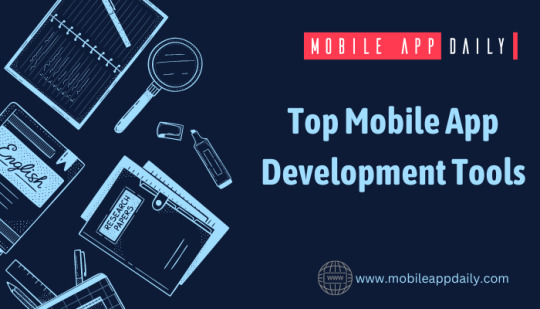
Why Choose the Right Development Tools?
Before we dive into the specifics, let's understand why choosing the right development tools is crucial for your app's success. The choice of tools can significantly impact the development process, affecting factors such as speed, scalability, and overall quality. By selecting the appropriate tools, you can streamline the development process, reduce costs, and ensure a seamless user experience for your app.
Top Mobile App Development Tools
1. Flutter
Using a single codebase, Flutter is an open-source UI software development kit created by Google that can be used to construct native desktop, web, and mobile applications. Developers can see their code changes reflected in the app instantly thanks to the hot reload feature, which streamlines the development process.
2. React Native
React Native, maintained by Facebook, is another popular framework for building cross-platform mobile applications. It enables programmers to create native-like experiences for the iOS and Android platforms by using JavaScript code. React Native's extensive library of pre-built components simplifies development and accelerates time-to-market.
3. Xamarin
Xamarin, now a part of Microsoft's Visual Studio, is a robust framework for building cross-platform mobile apps using C#. Developers can leverage their existing C# skills and share a significant portion of code across multiple platforms, saving time and resources. Xamarin provides access to native APIs, ensuring high performance and native-like user experiences.
4. Ionic
Ionic is an open-source framework for building cross-platform mobile applications using web technologies such as HTML, CSS, and JavaScript. It offers a library of pre-designed UI components and a command-line interface for efficient development. With Ionic's platform-specific styling and native functionalities, developers can create visually appealing and performant apps.
5. NativeScript
NativeScript enables developers to build truly native mobile applications using JavaScript, TypeScript, or Angular. It provides direct access to native APIs, allowing for seamless integration with device features and capabilities. With NativeScript, developers can create high-performance, visually stunning apps that deliver a native user experience.
Conclusion
The success of your mobile app hinges on various factors, including the choice of development tools. By selecting the right tools suited to your project requirements, you can expedite the development process, enhance app performance, and ultimately delight your users. Whether you prioritize efficiency, code reusability, or native-like experiences, there's a mobile app development tool out there to suit your needs.
0 notes
Text

In the dynamic realm of mobile app development, choosing the right framework can significantly influence the success of your project. At DextrousInfosolution, we understand the importance of leveraging cutting-edge technologies to craft exceptional mobile applications. In this article, we explore the top mobile app development frameworks that empower our team to deliver innovative solutions tailored to our clients' needs.
Flutter: Developed by Google, Flutter has gained immense popularity for its ability to build cross-platform applications with a single codebase. Its hot reload feature facilitates rapid iteration, allowing developers at DextrousInfosolution to efficiently create visually stunning and performant apps for both Android and iOS platforms.
React Native: Backed by Facebook, React Native enables the development of native-like mobile applications using JavaScript and React. Its modular and intuitive architecture streamlines the development process, enabling our team to deliver high-quality apps that offer seamless performance and user experience.
Ionic: Leveraging web technologies such as HTML, CSS, and JavaScript, Ionic empowers developers to build cross-platform mobile applications with a native-like look and feel. With its extensive library of pre-designed components and plugins, DextrousInfosolution harnesses the power of Ionic to create feature-rich apps that cater to diverse business requirements.
NativeScript: Offering the flexibility of using TypeScript, Angular, or Vue.js, NativeScript allows our developers to build truly native mobile applications. By accessing native APIs directly, we can deliver superior performance and leverage platform-specific features, ensuring that each app developed by DextrousInfosolution delivers a seamless user experience.
Xamarin: Powered by Microsoft, Xamarin enables the development of cross-platform mobile applications using C# and .NET. Its robust integration with Visual Studio and extensive library of native APIs empower our team to create sophisticated apps that run smoothly on various devices, maximizing reach without compromising on performance.
At DextrousInfosolution, we recognize that the choice of mobile app development framework is paramount to the success of every project. By staying abreast of the latest advancements in technology and meticulously selecting the most suitable framework for each endeavor, we consistently deliver innovative solutions that exceed our clients' expectations.
Whether you're looking to create a feature-rich mobile application for your business or seeking to revamp your existing app, partner with DextrousInfosolution, the top mobile app development company committed to turning your vision into reality. Contact us today to embark on your journey towards mobile app excellence.
Content Reference Link - https://www.dextrousinfo.com/app-development/unveiling-the-top-mobile-app-development-framework-for-your-next-project
0 notes
Text
How to Use Angular for Its Mobile-First Development Capabilities
In the ever-evolving landscape of web development, the shift towards mobile-first design principles signifies a fundamental change in how developers approach project creation. With mobile devices becoming the primary means of accessing the internet for a majority of users worldwide, developers are increasingly tasked with building applications that not only function seamlessly across a wide range of devices but also prioritize mobile experiences from the ground up. Angular, a platform and framework for building single-page client applications using HTML and TypeScript, stands out as a particularly powerful tool for embracing mobile-first development. This blog post explores how to leverage Angular for its mobile-first development capabilities, ensuring your applications are optimally designed for the smallest screen, without compromising functionality or user experience as you scale up to larger devices.
Understanding Mobile-First Design
Mobile-first design is an approach where designing for mobile devices takes precedence over desktop designs. This method doesn't just imply making designs responsive; it involves a complete paradigm shift in the development process. The core principle behind mobile-first is not only about adjusting screen sizes but also considering the constraints and capabilities of mobile devices, including load times, navigation structures, and touch interactions.
Why Angular for Mobile-First Development?
Angular's comprehensive suite of tools, libraries, and design patterns make it an ideal choice for developers looking to adopt a mobile-first approach. Here are several reasons why:
Responsive Design Support: Angular facilitates the development of responsive applications that can adapt to various screen sizes and orientations effortlessly. This adaptability is crucial for mobile-first designs, where user interfaces must remain functional and aesthetically pleasing across devices.
Performance Optimization: Angular's ahead-of-time (AOT) compilation, lazy loading, and efficient change detection mechanisms ensure applications load quickly and run smoothly on mobile devices, which may have limited processing power compared to desktops.
Cross-platform Development: Tools like Ionic or NativeScript work seamlessly with Angular, allowing developers to build mobile applications that feel native to iOS and Android from a single codebase, significantly reducing development time and effort.
Material Design Components: Angular Material offers a collection of high-quality UI components that are optimized for mobile devices, ensuring a consistent look and feel across platforms while adhering to modern design principles.
Elevate your project, Hire Angular developers! Contact us now to bring your vision to life with cutting-edge web solutions.
Step-by-Step Guide to Leveraging Angular for Mobile-First Development
1. Setting Up Your Angular Project
Start by installing the Angular CLI, a command-line interface tool that you use to initialize, develop, scaffold, and maintain Angular applications directly from a command shell. Initialize your project by running:
bashCopy code
ng new my-mobile-app
Choose the setup options that best suit your project, focusing on mobile-first considerations like performance and responsiveness.
2. Designing for Mobile-First
Start with Mobile Layouts: Begin your design on the smallest screens. Use CSS media queries to create responsive layouts that expand or adapt as the screen size increases.
Optimize Images and Assets: Ensure that images and other assets are optimized for mobile devices to reduce load times. Consider using Angular's lazy loading feature to load resources on demand.
Implement Touch Gestures: Use Angular's HammerJS integration to add touch gestures that enhance the mobile user experience.
3. Enhancing Performance
Use AOT Compilation: Enable AOT compilation to pre-compile application components before the browser downloads and runs the code, reducing the application's load time.
Implement Service Workers: Use Angular's service worker support to cache application data and assets. This not only improves performance but also allows your application to run offline, enhancing the mobile experience.
Lazy Load Modules: Structure your application into feature modules and use lazy loading to load them as needed. This strategy significantly reduces the initial load time, a critical factor for mobile users.
4. Testing on Mobile Devices
Use Angular's Dev Tools: Leverage Angular's development tools to simulate various devices and screen sizes during the development process.
Real Device Testing: Test your application on actual devices to ensure it performs well and provides a good user experience across different platforms and screen sizes.
5. Building with Cross-Platform Tools
Consider using a framework like Ionic or NativeScript with Angular for projects that require a native mobile application. These tools allow you to maintain a single codebase for both web and native mobile applications, streamlining the development process while ensuring consistency across platforms.
Best Practices for Mobile-First Development with Angular
Prioritize Performance: Always consider the performance implications of your design and development choices. Mobile users often have limited bandwidth and processing power.
Focus on User Experience: Mobile-first design is not just about making things fit on smaller screens. It's about considering how users interact with your application on a mobile device.
Keep It Simple: Start with the minimum viable product (MVP) and gradually add features as needed. A clutter-free interface is crucial for mobile devices.
Test Extensively: Beyond standard functionality testing, focus on usability testing across various devices and browsers to ensure a consistent and positive user experience.
Discover the top Angular development companies to transform your ideas into reality. Get in touch today and start building with the leaders in Angular technology!
Conclusion
Embracing a mobile-first approach in web development is no longer optional but a necessity in today's mobile-dominated world. Angular provides a robust framework for building applications that are not only responsive but also optimized for performance, usability, and scalability across devices. By following the principles and steps outlined above, developers can harness the full potential of Angular for mobile-first development, creating applications that meet and exceed the expectations of the modern mobile user. Whether you're building for the web, native mobile platforms, or both, Angular offers the tools and flexibility needed to deliver outstanding mobile-first applications.
0 notes
Text
Which Front-End Framework Should You Pick in 2023 Between Angular and React?

The world is running after technology and digitalization, those who are running the web development industry are looking for more innovations. If you are someone who is struggling to choose the right front-end framework, then this article is for you. As we step into the digital canvas of 2023, the contenders that stand at the forefront are angular vs react, both wielding their distinctive strokes of brilliance. Just like an artist deliberates over colour palettes and brush strokes, developers now deliberate over intricate features, performance, and community support.
The stakes are high, and the decision is crucial. Shall you dance with Angular's structured elegance or sway to the dynamic rhythms of React? Let's unveil the canvas, explore the hues, and discover the brushstrokes that will shape your digital opus. Welcome to the enthralling duel of angular vs react performance, a showdown that will define the aesthetics of web development this year. This way you will easily understand which web app development services you should opt for your business. Hence read the article till the end!
What is Angular?
Angular is a popular open-source front-end web application framework primarily maintained by Google and a community of developers. It is widely utilized for building dynamic, single-page web applications (SPAs) with a focus on a robust architecture and seamless user experience. Initially released in 2010, Angular has seen significant advancements over the years, with the latest version being Angular 12 at the time of my last update in September 2021.
Angular operates on a TypeScript-based programming language, which enhances the structure and maintainability of the code. It implements a component-based architecture, breaking down the application into modular, reusable components. These components encapsulate HTML templates, CSS styles, and the application logic, promoting code reusability and easier maintenance.
One of the most important characteristics of Angular is its two-way data binding, which allows for the automatic synchronisation of the model (data) and the view (UI). Changes in one are automatically mirrored in the other, speeding the development process. Furthermore, Angular provides a diverse set of built-in directives, dependency injection, and extensive testing capabilities, making it a versatile and efficient framework for developers.
Advantages Of Angular
Angular, a popular front-end web application framework, offers numerous advantages that contribute to its widespread adoption and use in modern web development:
Dependency Injection: Angular's built-in dependency injection system facilitates the management and sharing of dependencies among different components. It enhances modularity, testability, and reusability of code.
TypeScript: Angular is built with TypeScript, a superset of JavaScript framework that adds static typing. This enables developers to catch errors during development, making the codebase more robust and easier to maintain.
MVVM Architecture: Angular follows the Model-View-ViewModel (MVVM) architectural pattern. This separation of concerns helps in maintaining a clean codebase, simplifying testing, and improving collaboration among developers.
Enhanced Productivity: Angular provides a wide range of pre-built tools, libraries, and features that expedite development. Features like Angular CLI (Command Line Interface) and Angular Material for UI components boost productivity.
Cross-Platform Development: With Angular, you can develop applications for various platforms like web, mobile, and desktop using frameworks like NativeScript or Ionic.
What Is React?
React is a popular open-source JavaScript library primarily used for building user interfaces and single-page applications where smooth and responsive user experiences are essential. It was created and is now maintained by Facebook and a community of independent developers and businesses.
Key features and aspects of React include:
1. Component-Based Architecture: React is based on a component-based architecture, where the user interface is broken down into reusable, self-contained components. These components can be developed, maintained, and reused independently, making the development process efficient and modular.
2. Virtual DOM (Document Object Model): React utilizes a virtual DOM, a lightweight copy of the actual DOM. This virtual representation allows React to efficiently track changes and updates in the application, minimizing the need to manipulate the real DOM and improving performance directly.
3. Declarative and Reactive: React enables developers to describe how the UI should look based on the application's state. Instead of imperatively defining each change in the UI, developers declare the desired UI state, and React automatically handles the updates when the state changes.
4. JSX (JavaScript XML): React uses JSX, a syntax extension for the JavaScript framework that resembles XML or HTML. JSX allows developers to write HTML-like code within JavaScript, making the code more readable and efficient. JSX is transformed into regular JavaScript before rendering.
5. Efficient Data Binding: React utilizes a unidirectional data flow, which ensures that changes in a component's state automatically trigger updates in the UI. This simplifies tracking and managing data changes, enhancing application efficiency and predictability.
6. Strong Community Support: React has a large and active community of developers, providing extensive documentation, tutorials, and support. This community-driven aspect contributes to the framework's continuous improvement and adoption of best practices.
Advantages of React
React, an immensely popular JavaScript library developed and maintained by Facebook, offers many advantages that make it a top choice for building dynamic and interactive user interfaces. Here are the key advantages of React:
Reusability and Composability: Components in React are designed to be reusable. Once a component is created, it can be reused across different parts of the application or even in entirely different projects. This reusability promotes a modular and efficient development process.
Virtual DOM for Enhanced Performance: React utilizes a virtual DOM, a lightweight copy of the actual DOM. Instead of directly manipulating the real DOM for every change, React compares the virtual DOM with the previous version and only updates the necessary parts. This minimizes DOM manipulation, leading to improved performance and responsiveness.
Efficient Data Binding: React employs a unidirectional data flow and a concept called "one-way data binding." This means that the flow of data in the application is predictable and consistent, simplifying data tracking and rendering updates. Any changes in the application state trigger a re-render of the affected components, optimizing performance.
JSX for Readability and Productivity: JSX, a syntax extension for JavaScript, allows developers to write HTML-like code directly within JavaScript files. This enhances code readability and maintainability, resembling the structure of the UI and making it easier for both designers and developers to collaborate.
The Final Thought
In the dynamic realm of web development, the choice between Angular and React in 2023 ultimately hinges on your project's specific needs and your team's familiarity and preferences. Angular shines with its strong opinionated structure, two-way data binding, and comprehensive feature set, making it an excellent choice for large, complex applications where a full-fledged framework is beneficial. On the other hand, React, with its flexible and minimalist approach, is perfect for projects where you need fine-grained control over components and state management. Angular vs react frameworks have evolved to be highly efficient and robust, supported by vibrant communities and extensive ecosystems. The best decision is one that aligns with your project's goals, ensuring you craft exceptional web experiences in the ever-evolving tech landscape. So now that you know the difference between angular vs react performance you might make up your mind for which one to choose. If you are also seeking web app development services then feel free to contact IBR Infotech anytime for your queries and we will help you out.
#professional web development services#best website development company#full stack web development services
0 notes